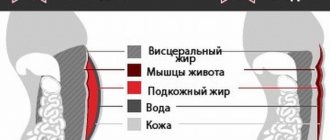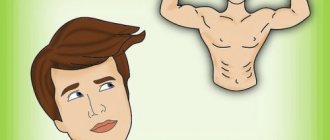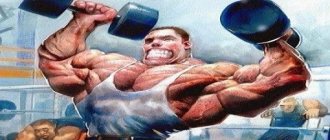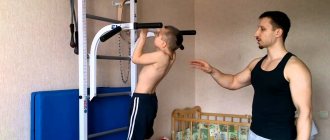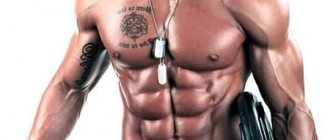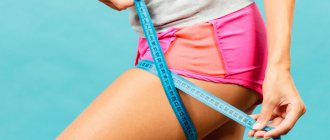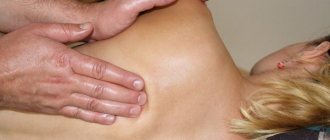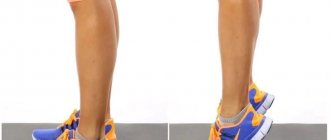Facilitates venous blood flow
If you spend the whole day on your feet, excess fluid accumulates in the lower extremities and the venous system is under greater strain. The veins of the lower extremities already have to push blood from the bottom up, resisting gravity. When you lift your legs up, you facilitate the outflow of venous blood. This pose is useful, for example, for patients with varicose veins, but not only for them.
Know that the absence of a venous network or large dilated veins in the legs does not mean that you do not have venous insufficiency. You can only visually assess the superficial veins, but the condition of the deep veins of the legs is more important. They are equipped with valves that prevent blood stagnation. But walking for a long time or standing on your feet, especially in uncomfortable shoes, can irreversibly damage your venous valves. Temporary stagnation occurs after drinking alcohol, walking in hot weather, air travel, and when taking large amounts of liquid.
Interesting fact!
If your scale at the end of the day shows one or two kilograms more than in the morning, this is a direct sign that you have edema. Instead of exhausting yourself with a diet or taking diuretics, solve the problem with a simple exercise - lie down before going to bed with your legs up.
Headstand: execution technique
While performing the asana, you should avoid common mistakes so as not to cause yourself more harm than good. First of all, you should pay attention to the neck - there should not be any discomfort in this area or excessive stress. Body weight should be supported by the arms and shoulder girdle. The elbows should not be moved too narrowly or, conversely, spread too wide - this will create additional stress on the neck and prevent you from achieving balance when performing the asana. You should enter and exit the asana slowly, avoiding any jerks - sudden movements will not lead to anything good in this case. You should also come out of the asana by slowly lowering your legs to the floor, and not falling like a bag. If this happens, this indicates that the muscles are still weak and cannot allow the legs to be slowly raised and lowered; in this case, the back muscles should first be strengthened by performing other asanas.
What does a headstand do?
So, let's summarize. What does a headstand do?
- Rejuvenates and strengthens the body.
- Stimulates the thyroid and pineal glands.
- Promotes the production of melatonin.
- Provides blood flow from the legs, which will quickly relieve fatigue and alleviate the condition of varicose veins.
- The inverted position of the body gives rest to the heart.
- A rush of blood to the head ensures healthy eyes and, over time, even the disappearance of gray hair.
- A rush of blood to the head improves blood circulation in the brain.
- Holding the body in an inverted position develops concentration and increases the ability to meditate.
- At the energy level, it allows you to raise energy from the lower chakras to the upper ones, which contributes to a more harmonious development of the personality.
- Performing the asana develops the muscles of the neck, arms and shoulder girdle.
- Rejuvenation and cleansing of the digestive organs due to improved blood circulation.
- With long-term and regular practice, wrinkles are smoothed out.
For Beginners: How to Do a Headstand
Those who are just taking their first steps in yoga are not recommended to be fanatical about mastering the headstand. First, you should master less complex inverted asanas in order to experience from personal experience the principles of being in them and track what sensations arise in the mind and body, as well as choose the optimal state of being in an inverted body position for yourself.
The first step is to master Halasana, and then Sarvangasana. When you have achieved a stable, stable position in Sarvangasana, you should try mastering the headstand. It is recommended for a beginner to master a headstand near a wall so that there is no danger of losing the balance of the body and falling back on your back. However, you should not linger long at this stage of mastery and, over time, move on to full performance of the asana. It is worth noting once again that while performing the asana, the weight of the body, contrary to its name, should not be on the head, but on the elbows and shoulder joints.
Sirsasana
The head should touch the floor at a certain point, this point is approximately 4-5 cm from the hairline. Place your palms on your elbows - in this position, the distance between the elbows will be the distance that must be maintained when performing a headstand. So, kneel near the wall, place your elbows at the distance described above, clasp your hands in a lock, place the back of your head in the resulting lock, your head should touch the floor at the point described above - 4-5 cm from the hairline.
Next, you should straighten your legs and try to form the most acute angle between your legs and torso. Now you should raise your legs up - don’t be afraid to fall back, because you have a wall behind you, and if you fall forward, you will instinctively always have time to straighten your legs. When you have managed to raise your legs up, you should find the balance point and try to find balance in order to stand without tension and fear of falling. If you can’t immediately raise your legs up, you can try the following options:
- When you have managed to lift your feet off the floor, try raising your bent legs and perhaps practice this variation for now, gradually moving towards the final position with your legs straight up.
- If you lose your balance, immediately when you lift your toes off the floor, try to lift only one leg, and then lift the other leg, while trying to maintain your balance. If this fails, it means that weak back muscles do not allow this to be done. You should strengthen your back muscles by practicing Sarvangasana and other asanas that are aimed specifically at developing the back muscles, for example, Bhujangasana or Chakrasana.
Finally, it is worth once again warning against fanaticism in the matter of mastering complex asanas. If you cannot perform an asana for some reason, you should find out the reason and work on those parts of the body whose lack of development prevents you from performing the asana. A headstand is only useful if performed correctly. In case of errors during execution, the effect may, to put it mildly, not be exactly what is expected.
https://youtu.be/d6LFZokty2Q
Muscles rest and energy returns
When you raise your legs, you tighten the muscles and tendons of the thigh and lower leg. Gravity, while you lie upside down, tones your muscles as if you were tensing them while doing light exercise. But this is not the only benefit of this position.
To keep our body upright, four muscle groups tense throughout the day:
- The first group
is the muscles of the back of the thigh, which extend the ankle joint. - The second group
is the muscles of the anterior thigh that extend the knee joint. - The third group
is the muscles of the pelvis and lower back, which keep the hip joint straight. - The fourth group
is the erector spinae muscles.
You do not feel the work of these muscles, but the feeling of weakness in the evening is due to the fact that acidic substances have accumulated in the muscle tissue. To normalize the acid-base balance, muscles secrete lactate, a salt of lactic acid. Despite the popular belief that lactate is harmful, a 2020 study at the University of California showed that muscles can reuse it as an energy source if it is reduced in the liver to glucose and returned as one of its breakdown products back to the muscles with blood. Read more about the study by following the link in the bibliography. But for lactate to turn into glucose, it must enter the blood, reach the liver and return back to the muscles. You can speed up the process of flushing lactate from your muscles by lying with your feet up. Firstly, this way you will relax your muscles, and secondly, it will facilitate the outflow of blood.
Interesting fact!
Lactate is formed in the muscles, even if you have not experienced any stress, but, for example, just sat in an office chair all day.
Upavistha konasana
The next asana, which will help you learn how to throw your leg over your head, is also used to do the splits. In both cases, it is important to stretch the inner thigh, which is what this exercise does.
Sit on the floor and spread your legs as wide as possible. Raise your arms up and straighten your back. As in the previous asana, take a deep breath and lower yourself as low as possible with your back straight.
Reduces back pain
The leg-raising pose can be considered as an option for inversion therapy. This is a recognized method of treating and preventing spinal diseases according to the recommendations of the American College of Physicians. In classical inversion therapy, your body is inverted so that your heart is higher than your head. The essence of the therapy is to temporarily relieve the spine of the heaviness it experiences due to gravity. But you don't have to hang upside down. It is enough to raise your legs and lie on a smooth surface without placing a pillow under your head.
Even in this “light” version, the spine is stretched and pressure on the discs and roots of the spinal cord is reduced. After 15 minutes of staying in this position, you will feel that your back pain has decreased significantly. By regularly performing this exercise, you can even relieve the symptoms of sciatica and scoliosis and reduce the likelihood of surgery. In this position, the muscles that straighten the spine, which are in a state of spasm due to pain, relax. The back becomes more flexible, so the risk of compression of the nerve roots and a new attack of pain is significantly reduced.
Important!
Before performing the exercise, make sure that you do not have the following contraindications:
- high blood pressure;
- sinusitis;
- nasal congestion;
- glaucoma;
- conjunctivitis;
- risk of retinal detachment;
- spinal or neck injuries;
- otitis;
- umbilical or inguinal hernia.
Why is it necessary to perform a set of exercises for the spine?
If the spine is well stretched, then its vertebrae do not compress the nerve tissue, which is why the energy of nerve impulses travels better to different organs.
You can ensure long-term health of the spine by strengthening its muscle corset; for this you should perform exercises for the muscles. Thanks to them, the ligaments that support the spine in a stretched form are improved.
If the spine is well stretched, you will have correct posture. Blood circulation is restored, and due to the fact that the pressure on the vertebrae is evenly distributed, the general condition of the body improves and energy appears. Internal organs will become stronger, breathing will normalize, and oxygen will flow better into the cells.
After doing exercises for the spine, within a couple of weeks you will understand that the general condition of the body is improving, you feel energy, pain in the muscles and vertebrae will decrease or completely disappear, and a feeling of flexibility in the muscles and flexibility in the vertebrae will appear. There are several conditions that must be met to perform the exercises:
- When starting to do exercises to develop muscles and joints, do not overdo it;
- perform loads according to your capabilities;
- Do not perform exercises with a maximum range of motion.
You can’t do the whole set of exercises at once, especially if you haven’t trained much before or a lot of time has passed since the previous workout (weeks or months). Don't overwork your body and don't expect instant results. The first change in the condition of the muscles and vertebrae occurs over time after regular exercise.
Exercises for the spine should become a daily procedure, like brushing your teeth or having breakfast, only then will you have the energy to do them.
At first, performing exercises for the flexibility of joints and muscles should be done at a slow pace; you should feel how all the vertebrae are stretched, how energy appears. If after doing the exercises there is pain and fatigue, you should rest or reduce the load, but do not quit training. After some time, relief comes, you will become more resilient and have energy.
In the first days, do not repeat the complex more than 2-3 times. When you realize that the load is not enough (about day 4-5), repeat the complex about five times. In a week you will feel that there is a surge of muscle, restoration of flexibility of the spine, that the treatment is effective, and energy will appear. If you have not previously done much physical exercise, then after a few workouts you will be able to perform the entire complex without problems.
The most important thing in treatment is to force yourself to do exercises every day. Only thanks to this can the curvature be corrected and the entire body, including the muscle corset, brought into healthy tone. After three weeks, the improvements that appear will be firmly established and the number of exercises can be reduced to 2 times a week. If you feel the first improvement, do not stop exercising.
If you are predisposed to spinal disease or lead an unhealthy lifestyle, you need to make exercise a mandatory program.
Lymphatic drainage is carried out
For lymphatic drainage, it is not necessary to sign up for an expensive procedure at a beauty salon. Lying on your back with your legs raised can significantly help the lymphatic system of the lower extremities in removing excess tissue fluid - lymph. Lymph is 96% water, so even with a healthy venous system, your legs may swell due to lymph stagnation. Despite the fact that lymphatic vessels are very similar in structure to veins, and they also have valves, they are almost devoid of elasticity, and therefore the pressure in them is lower than in the veins. All this means one thing - no elastic bandages or tights will help you cleanse the lymph. But this can be done by simply raising your legs up.
There is a significant difference between lymphatic and venous edema. If during normal swelling your tissues are simply compressed by excess “water,” then when lymph stagnates, cleansing does not occur in them. The lymphatic system of the legs needs a temporary “rest from gravity”. With poor lymphatic drainage, about 83% of toxic products accumulate in the fluid that surrounds the cells. Lymph that is not filtered in time contains toxins, cell waste products, harmful microbes and even cancer cells. This condition is called lymphotoxicosis.
Important!
This method can facilitate lymphatic drainage only if the stagnation is bilateral. If you only have swelling in one limb, you should see a doctor immediately.
Interesting fact!
When lymph stagnates, tissues do not receive the substances they need, the delivery of which is carried out not with the blood, but through the lymph. For example, lipids are absorbed from the intestine not into the blood, but into the lymphatic vessels. The protein that comes from the blood into the tissues returns back to the bloodstream through the lymph, so when lymph stagnates, a low protein content is detected in a blood test.
The heart is unloaded
With a significant load on the lower extremities, a large volume of blood enters them. The heart is forced to pump blood under high pressure in order to deliver it to all tissues. Consequently, in order to provide the required volume of blood under increased load, the heart is forced to contract more often. When we lie with our legs raised up, the heart muscle rests. Blood flow to the heart increases, and between contractions the chambers of the heart are filled with more of it. The more the myocardium stretches during filling, the stronger the heart muscle contracts. Therefore, in the “legs up” position, your pulse slows down. This position is especially useful for people prone to low blood pressure and headaches.
However, if you have been diagnosed with heart failure, arterial hypertension and arrhythmia, it is better not to practice this exercise. The effect may be the opposite - you will experience an attack of palpitations and shortness of breath. People with serious heart pathology are recommended to lie with the head end of the bed elevated.
Calms the nervous system and restores brain function
By redistributing blood flow in an inverted position, you direct more blood, oxygen and glucose to the brain. This can solve several problems at once - eliminate headaches, cure insomnia and eliminate nervous tension. This position also “trains” the nervous system, restoring its ability to quickly regulate blood pressure and even improves memory.
Important!
If you have high intracranial pressure, you should not lie in this position.
Interesting fact!
Inversion therapy is practiced by many famous people. For example, actor Jackie Chan and author of the novel “The Da Vinci Code” Dan Brown. According to the latter, the inverted position helps him “regain clarity of mind.”
Improves appearance
By regularly doing this exercise, you can improve the condition of your skin and hair, slow down the appearance of gray hair, and even tighten your facial muscles. Doctors explain the anti-aging effect by improving blood flow in the upper parts of the body, improving metabolism in the body and the calming effect of this position.
Interesting fact!
The “legs up” position gained its popularity after the massive spread of yoga, where it was known as “Viparita Karani”. In Sanskrit it means "upside down, but in action." According to Eastern teachings, this pose bestows youth by directing all vertical flows in the opposite direction. This is a completely natural state for our body. Remember that a healthy baby spends almost all of his time lying down, and if he is not swaddled, you can notice how he lifts his legs up.
Headstand: benefits
Just as the miraculous elixir of the alchemists grants initiates eternal life, performing a headstand can reverse the aging process. This is stated in the Hatha Yoga Pradipika: “The body ages because the Sun consumes and destroys all the divine nectar - amrita produced by the Moon.” The Moon, which is discussed in this text, is located in the sky or, according to other sources, in the forehead, and the Sun is called Manipura - the fiery chakra responsible for the fire of digestion. It is in this fire that the so-called “lunar nectar” - amrita produced by the Moon - burns.
It is the combustion process of amrita that causes aging. And in order to reverse the aging process, you should take an inverted position, and then, driven by the force of gravity, the “lunar nectar” will move back - towards the head, where it will accumulate. From the point of view of modern science, when the body takes an inverted position, blood flows from the legs and internal organs and, under the influence of gravity, moves to the head and heart. This facilitates the functioning of the heart and cardiovascular system. The brain receives abundant blood circulation, which improves the metabolism in the brain cells, and this in turn improves brain activity and also balances the production of hormones. In particular, the inverted position of the body stimulates the pineal gland, which is responsible for the most important functions of the body.
Sirsasana
First of all, for the rejuvenation and restoration of both the physical body and our psyche. The pineal gland produces the hormone melatonin, which is involved in a number of important processes in the body. Melatonin production decreases significantly as we age, so doing a headstand that can stimulate the pineal gland and increase melatonin production can work wonders. Also, the pineal gland is responsible for a person’s intellectual and creative abilities, and they directly depend on its activity.
Thus, headstand can improve mental performance and even awaken creativity. The development and functionality of the pineal gland directly affects the ability to perform higher forms of meditation and the ability to concentrate deeply. So if you have difficulties with meditation practices, headstand is the best remedy. From the point of view of our energy body, the headstand promotes the movement of energy from the bottom up, which has an incredibly positive effect on our spiritual development and promotes rapid spiritual growth. Headstand stimulates the Ajna Chakra and Sahasrara Chakra, which are the most important for spiritual development.
Inverted asanas, mainly headstand, allow you to develop these chakras. It is worth noting that these chakras are responsible for human creative abilities and superpowers, such as clairvoyance, clairaudience, as well as the ability to control the consciousness of other living beings and “push through” reality.
How to do a headstand
Inspired by the wonderful properties that Shirshasana has, many people have a question: “How to perform it correctly and safely?” In fact, it is not nearly as difficult as it might seem at first glance. To begin with, it should be noted that contrary to its name, the headstand is not a headstand at all. That is, under no circumstances should the weight of the body be transferred to the head.
, this may cause serious neck injuries. The body weight must be supported by the muscles of the arms and shoulder girdle, and while performing the asana you should lean on your elbows placed near your head. You should put something soft under your head, for example, a blanket or blanket folded several times. You should place your head between your hands, gradually transferring your body weight to your elbows, and straighten your legs up. In this position, you should try to catch the balance point and maintain this position for several minutes. At the initial stage, it will be enough to stay in the asana for 30–40 seconds.
The thyroid gland is activated
All glands that secrete hormones need good blood flow. If you lie upside down every day, you can significantly improve blood circulation in the neck area where the thyroid gland is located. Its function suffers not only when there is obvious damage, but also due to chronic stress, which causes spasm of the supplying vessels. Symptoms such as fatigue, apathy, and drowsiness may be associated with insufficient production of thyroid hormones.
Important!
You should not perform the exercise if you have high thyroid hormone levels or a rapid heart rate. The flow of blood to the heart can trigger an attack of tachycardia.
Factors that negatively affect the health of the spine
Before performing exercises for the spine, it is worth eliminating harmful factors that negatively affect the muscle corset.
These include:
- Uncomfortable shoes cause many health problems, including the spine.
- Incorrect sitting at the table comes in second place. In the modern world, office employees, managers and anyone who spends a long time at a desk suffer from spinal diseases that arise as a result of improper sitting. Be sure to perform a small set of exercises to stretch the muscles and flexibility of the spine. Make sure your spine is straight and your shoulders are at the same level.
- A bent tailbone is a curvature of the last vertebrae. After the onset of the disease, severe pain is felt in the lower back. It can appear due to injury or improper sitting. You can get rid of the problem surgically or with the help of special exercises.
- The mattress is too soft. It is surprising that a special mattress that anatomically takes the shape of the body can cause curvature in the spine.
- Bad habits. Reluctance to perform any physical activity, laziness, alcohol and smoking. As well as harmful factors such as stress.
Reduces fat around the waist
It's hard to imagine that simply lying on your back with your legs stretched up will help you lose excess fat around your waist. But experts in the field of oriental medicine are convinced that fat accumulates where blood circulation is poor and toxins accumulate. Western evidence-based medicine confirms that with poor blood circulation, oxidative stress develops in the vessels. At the same time, harmful oxygen radicals destroy cells and maintain low-grade inflammation.
If your waist has increased due to internal fat in the abdominal cavity, when you raise your legs up, you disperse blood through the internal organs. This improves their function and restores mobility. As a result, metabolism improves and toxins are removed in time. The fat layer also receives its share of blood and stops releasing free radicals. Also, by helping the body fight obesity in the waist area, you significantly reduce the risk of developing type 2 diabetes.
Interesting fact!
If the fat layer does not receive enough blood, the body redistributes the blood flow so that there is enough for the fat cells, but because of this, other organs suffer. The more fat, the less organs receive blood, and the more substances are produced in the body that cause vasospasm and the production of oxygen radicals.
Exercises using the “Fukutsuji” method
A set of exercises for the spine can consist of just one five-minute task. The technique will help not only strengthen your back, but also lose weight and even grow taller. The Japanese founder of this method suggests just using a rolled up towel. This confidence in the result has already been proven by users of the technique. According to Fukutsuji, spinal compression and excess weight occur due to the fact that the pelvic bones and ribs are in the wrong position. If you put them in a natural position, your waist will decrease, your spine will stretch, and correct posture will appear.
To do this, it is enough just to lie on a cushion for a few minutes a day, correctly located in the lumbar region. The roller, as you gain experience in performing it, will need to be increased.
You need to lie on your back, place the cushion under your lower back in the place where your navel comes out. Legs straight are at a distance of 10 cm from each other. The arms are straight on the floor behind the head, palms down. The big toes and little fingers of the hands touch (this is very important!) to each other. So you need to lie down for 5 minutes every day. Once completed, you need to rise very slowly from your back. At first there may be discomfort, which gradually goes away.
Digestion is normalized
Raising your legs up is a great way to massage your internal organs. Chiropractors and osteopaths in the USA believe that all diseases begin due to impaired mobility of organs. When we take an “inverted” position, the organs move out of place. At the same time, blood flow improves in them. This leads to rapid cleansing of toxins and better absorption of nutrients. 15 minutes a day in this position helps to “stir up” the intestines and relieve you of chronic constipation.
Important!
Do not exercise immediately after lunch, a light snack, or even a cup of coffee, otherwise your blood pressure will rise sharply or your pulse will increase. For the same reason, you should not raise your legs if you have drunk a lot of alcohol or smoked several cigarettes.
Slim legs in 15 minutes
Hips and legs are one of the most problematic areas on the female body. This is where excess calories settle and treacherous cellulite appears . After 25-30 years, protruding vessels begin to show age and a tendency to a sedentary lifestyle... A set of exercises will give your legs an appetizing shape and improve blood circulation in just 15 minutes a day.
These exercises can be done at home and require nothing more than a regular exercise mat and a little patience. Exercise at least every other day, and in a maximum of a month your legs will acquire appetizing and toned contours, blood supply will improve, and the blood vessels will become less noticeable.
Leg swings while standing.
For this exercise you will need support. The back of a chair or door frame will do. We stand straight, holding the support with our hands. With a straight leg we do 15 swings to the side. Raise your leg as high as possible and hold it at the top point for a second or two, then slowly lower it. After 15 repetitions, perform the exercise on the other leg. Now stand sideways to the support and, holding on with one hand, swing your straight leg forward, and then take it back and up. As in the previous version, hold your leg for a second at the highest point, then smoothly lower it. Repeat the same with the other leg. This exercise warms up, stretches and tones the leg muscles well.
An additional advantage of the exercise: by swinging your legs, you also work on your abs. Make sure your body is motionless. While performing the movements, concentrate on the muscles of the thighs and abdomen. Feel how they tense up.
Swing your legs on all fours.
The exercise engages the gluteal and thigh muscles. Get on all fours with support on your palms and knees. Place your hands shoulder-width apart and raise your head slightly. It is important not to strain your neck while performing this exercise.
Slowly raise your right leg, bent at the knee at a right angle, as high as you can. Do not arch your back or move your body: the movement should be performed using the muscles of the thighs, buttocks and abdomen. Hold your leg in this position for a few seconds, then slowly lower it. Repeat at least 5 times for each leg. As your fitness increases, gradually increase the number of movements to 20.
Plie.
This exercise is used in ballet and Pilates. Place your feet shoulder-width apart, hands on your waist. On the count of “one”, slowly squat so that your knees remain in line with your feet. As you squat, gently raise your arms, spreading them to the side. On the count of two, slowly rise up. This is a very effective exercise for the outer and inner thighs. Do 1-2 sets of 15 squats. Rest no more than 30 seconds between sets.
"String".
Get on all fours, keep your back straight. Raise your right leg, pulling your heel toward you. The body and leg should form a single line and be stretched like a string. Do 30 intense up-and-down leg movements with minimal amplitude. Then return to the starting position and change legs. This exercise works all the leg muscles and gluteal muscles.
Swing to the side from a side lying position.
Lie on your right side, straight, with your head on your arm bent at the elbow. Your elbow should be in line with your shoulder and your body should be in a straight line. Raise your straight left leg up and lower it smoothly. Then, without pausing, pull your leg up with your knee to your shoulder without changing your original body position. Straighten your leg, lift it up again, lower it. Repeat this “double” movement (lifting - pulling to the shoulder) at least 3-5 times, but no more than 20 for each leg. Then roll over to the other side and change legs. The exercise wonderfully strengthens the inner muscles of the thighs and buttocks, and forms a beautiful waist.
Scissors.
Stand up straight with your arms and legs straight. Jump, while simultaneously spreading your legs and raising your outstretched arms above your head, as if imitating scissors. Return to the starting position with the same jump. The exercise requires good physical preparation and actively involves the respiratory system, and if you are not used to it, you may feel dizzy. Therefore, when starting training, be careful: for a test, perform the exercise 2-3 times and monitor your sensations. If you feel good, next time perform 5-7 jumps and gradually increase their number.
Swing your legs from a supine position.
Lie on your back with your arms at your sides. Stretch your legs and lift them above the floor to an angle of 30 degrees. From this position, move your legs up and down, your left and right legs alternately. This is a rather difficult exercise that puts stress on the lower abdominal muscles, as well as the upper and lower thighs. Start with 3-5 repetitions, gradually increasing the number of movements.
Final stretching and relaxation exercise.
Sit on the floor, spread your legs out to the sides as wide as possible. Alternately bend first to the right leg, then forward to the middle and to the left leg. Try to keep your back straight and stay at the lowest point of each position for 15-20 seconds. This exercise can complete the complex for the leg muscles. After this, it will be good to lie on your back, close your eyes and relax as much as possible for a few minutes. Think about something pleasant, don't move. Complete relaxation makes training more effective.
Supports genital function
When standing or sitting, the pelvic organs are also exposed to gravity. In women after childbirth or surgery in the perineal area, prolapse of the uterus, pelvic floor muscles and bladder may occur. Lying with your legs elevated, you pull your organs up, strengthen the ligaments and pelvic floor muscles, and blood flow helps you quickly cope with their chronic dysfunction.
Important!
Doctors warn that you should not do this exercise during pregnancy.
Interesting fact!
Lying down with your feet against the wall facilitates the outflow of lymph not only from the lower extremities, but also from the pelvic organs. This is an excellent prevention of inflammation of the genital organs, such as thrush. When lymph stagnates, toxins and bacteria enter from the lymphatic vessels onto the mucous membranes of the vagina in women and the urethra in men. So the lymphatic system tries to cleanse itself, but an inflammatory reaction develops on the mucous membrane.
Reduces pain during menstruation
Experts disagree on this issue. Some argue that such poses during menstruation are absolutely safe and even beneficial, because they relieve muscle spasms and calm the nervous system. But on the other hand, due to increased blood flow in the pelvic organs, you may lose more blood. Many doctors and even yoga experts do not recommend doing such exercises on “critical days.” There is a possibility that menstrual blood will partially flow in the opposite direction and enter the abdominal cavity through the fallopian tubes.
This development mechanism is attributed to endometriosis, a disease in which pieces of the uterine lining get onto the ovaries, peritoneum, rectum or bladder, and then become fixed to their walls. With each menstruation, these, so to speak, “implants” bleed. But this is possible if you don’t just raise your legs up, but complicate the task by lifting your entire torso.
